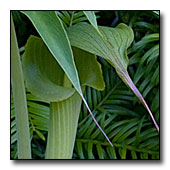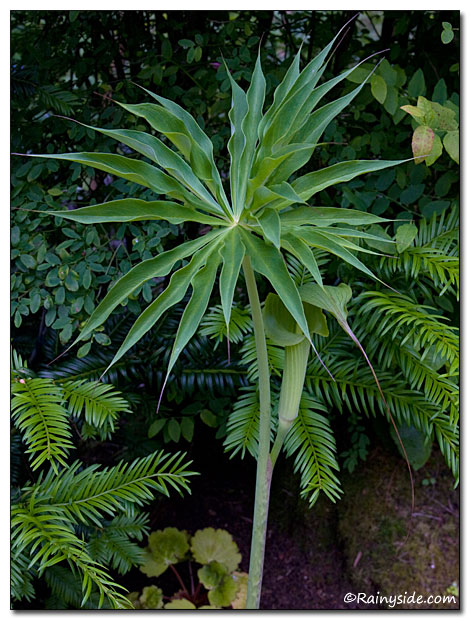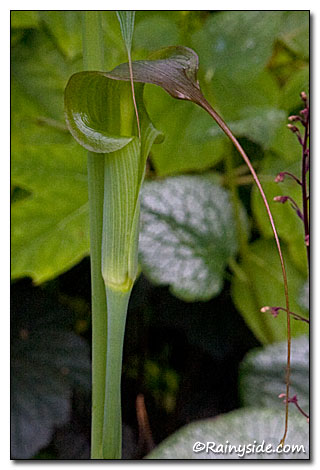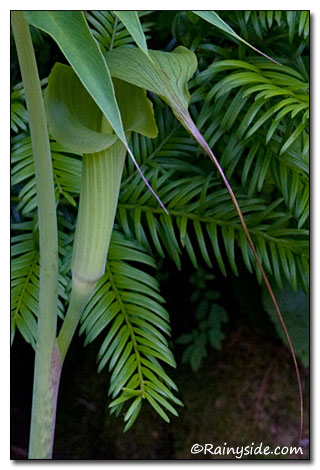Arisaema consanguineum
HIMALAYAN COBRA LILY, COBRA LILY
Family: Araceae
Pronounced: air-uh-SEE-muh kon-san-GWIN-ee-um

Quick Jumps
Growing Guide
Rainy Side Notes
GROWING GUIDE

Origin:
Himalayans, China, Philippines, North Thailand and North Viet Nam.
Plant Group:
Bulbs.
Hardiness:
Sunset zones: Not listed.
USDA zones: 5-9.
Heat zones: 9-7.
Mature size:
Height: 3-6 feet (1-2 m).
Width: 12 inches (30 cm).
Flowering period:
Early summer.
Flowering attributes:
A hooded, green to purple-brown striped, elongated spathe with a long tail, surrounds a green spadix and is followed by orange-red berries.
Leaf attributes:
Radiating out like an umbrella from a solitary stem are 11-20 or more 16-inch long and pointed leaflets with undulating margins and a long drip tip.
Growth habit:
Clump forming.
Light:
Full sun to full shade.
Soil:
Moist, well-drained neutral to acidic soil.
Feeding:
Side dress with compost. Fertilize in spring, again in early summer with a complete organic fertilizer.
Propagation Methods:
Sow seed making sure that the fleshy coating (pericarp) is no longer on the seed, so that germination is not inhibited.
Pests and Diseases:
Leaf rust may be a problem.
Rainy Side Notes


Arisaemas have such an exotic look in the shady garden; when it flowers, I want to peer down into its mysterious-looking hooded blossom. A striking whorl of leaflets form one radiatisect leaf, which achieves an umbrella-like topping above the long, mottled stem and flower. Each narrow leaflet has undulating margins and a long drip tip that channels rain outwardly, away from the stem and flower.
There are references that say these plants reach six feet tall. To see one taller than myself, and look up into a parasol of leaves above my head, would be a splendid experience. Nevertheless, the specimens I know reach a height of only three to four feet.
This species is one of the easiest of the Arisaemas to grow. They grow in a variety of settings, from dry, baking, rocky soils in full sun, to clay soils, and in moist soils alongside rivers in full shade.They look phenomenal when planted in groups of three or more, since each tuber sends up only one stem that is topped by a parasol of leaflets.
If you have the patience to grow aroids from seed, expect variations in flower color, silver mottling on the leaves, and the amount of leaflets that top the plant. When the flower fades, the stem bends towards the ground with its load of tightly packed, orange-red fruit. If you collect the seed for sowing, wear gloves while cleaning them to protect fingers from the calcium oxalate crystals found in the fruit.
Although the tubers and stems of A. consanguineum are used for medicinal purposes in India and in China, where the species is most widespread, the plant is toxic if not administered properly.
Photographed in Jonathon Morse's, Vashon Island garden.
A Pacific Northwest Plant of the Week (2013)

Gardening for the Homebrewer: Grow and Process Plants for Making Beer, Wine, Gruit, Cider, Perry, and More
By co-authors Debbie Teashon (Rainy Side Gardeners) and Wendy Tweton
Copyright Notice | Home | Search | Bulbs

